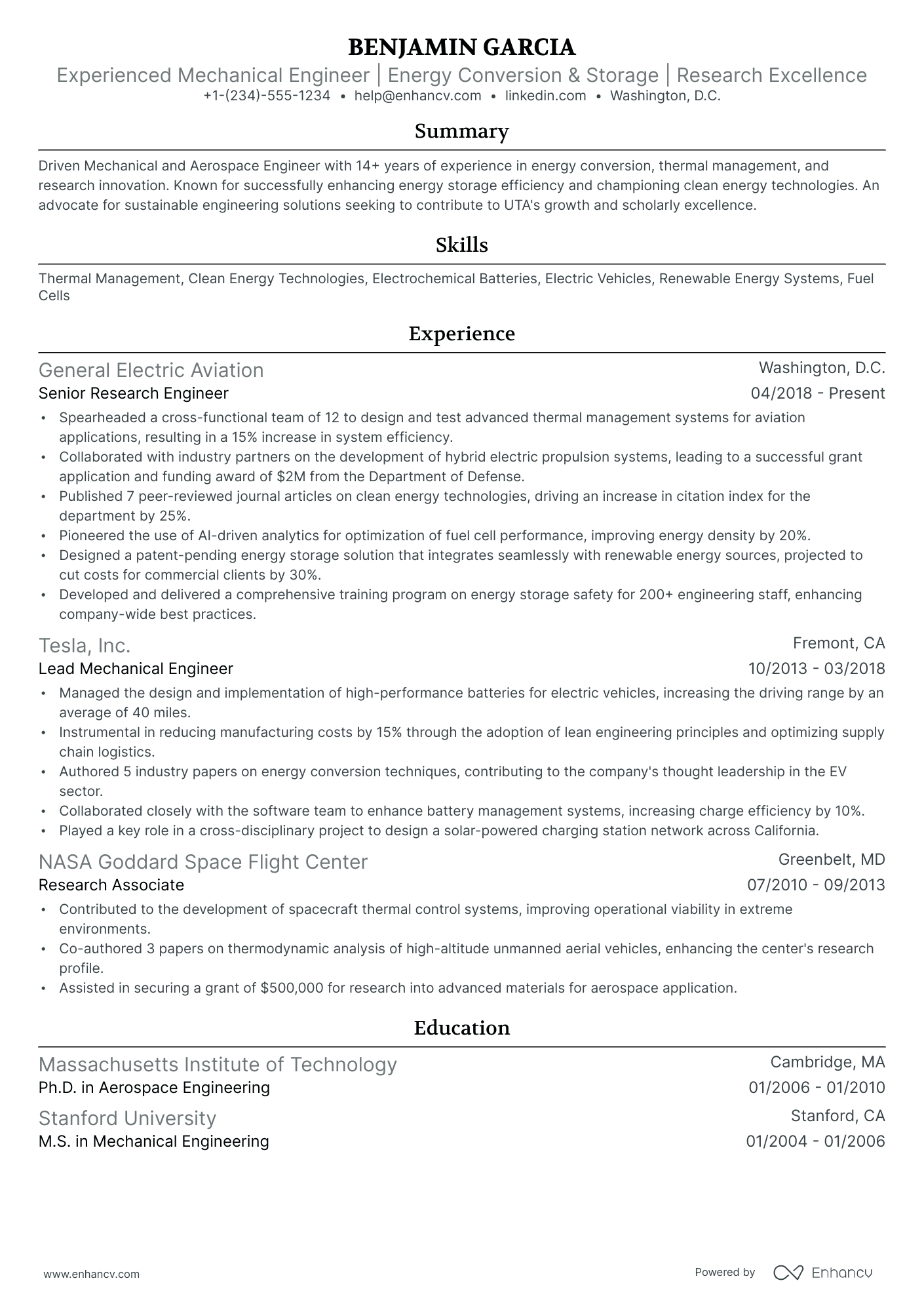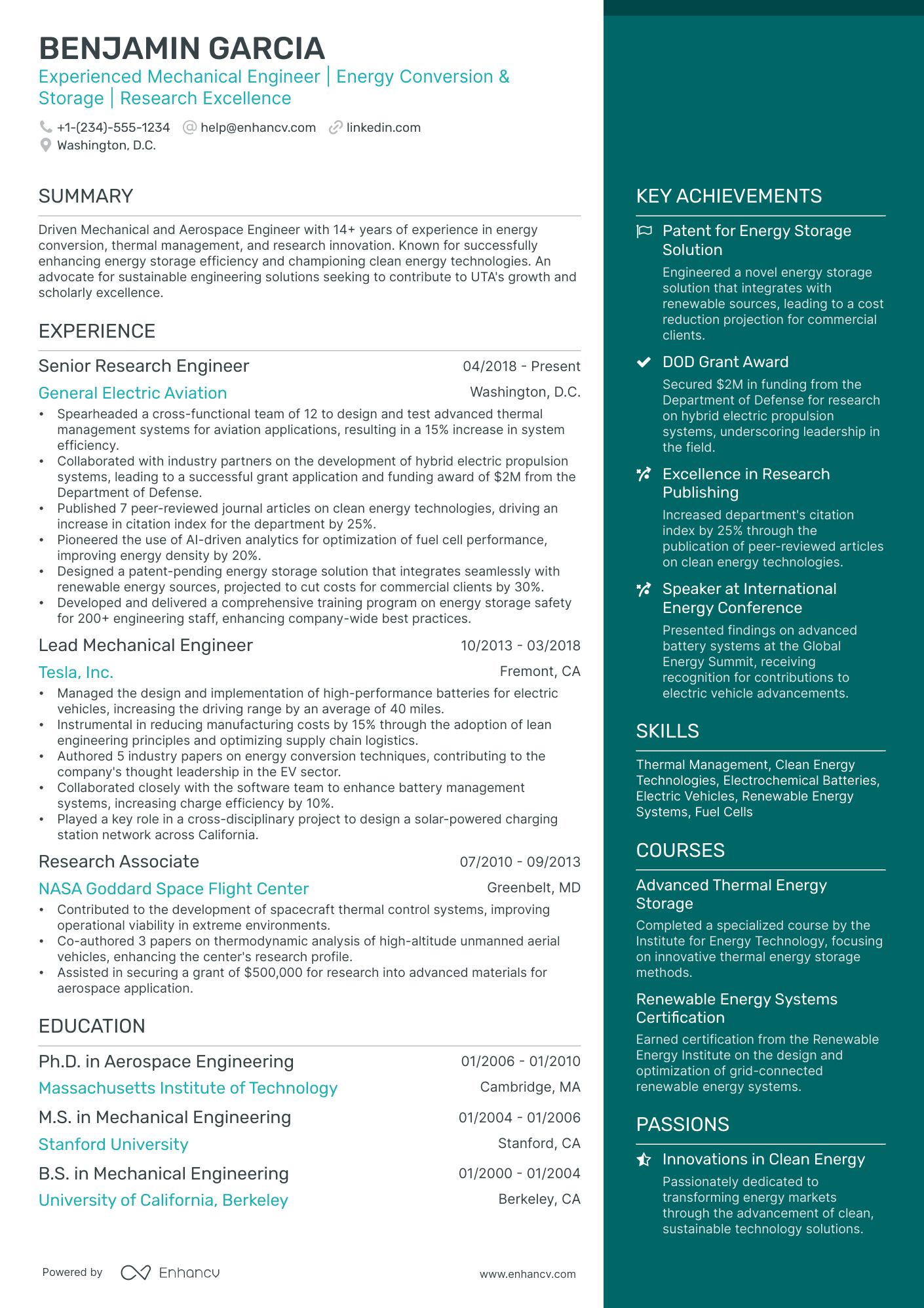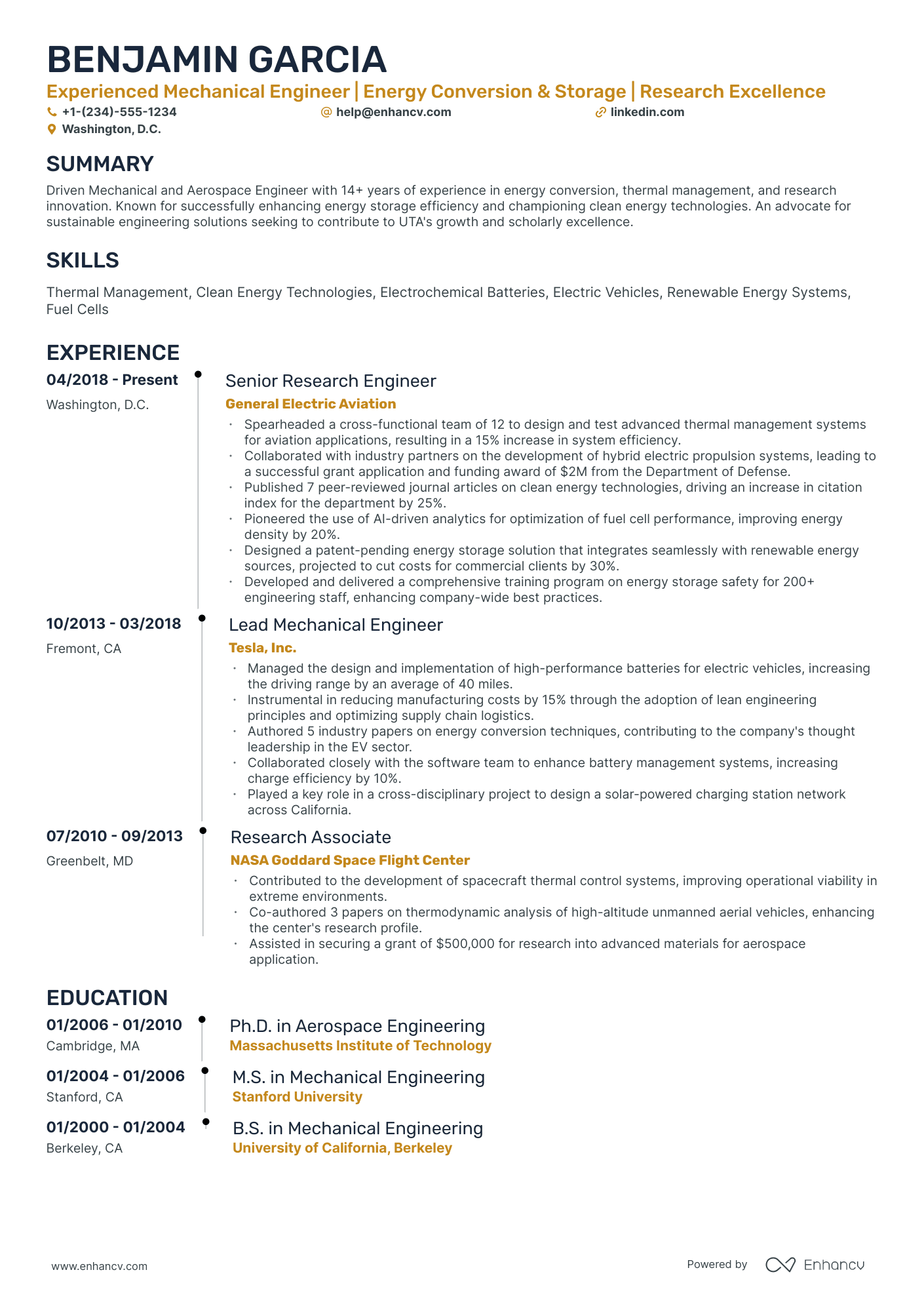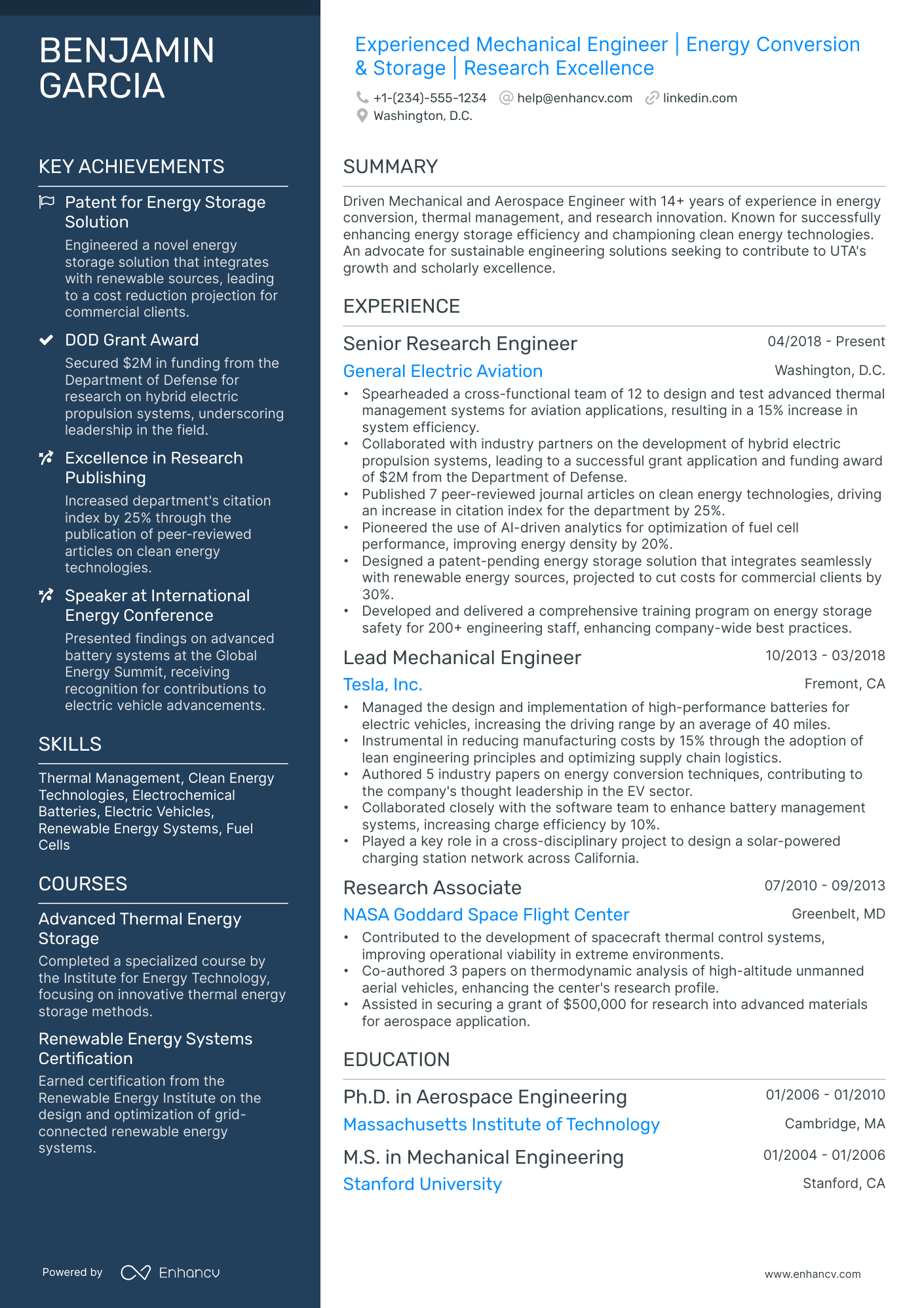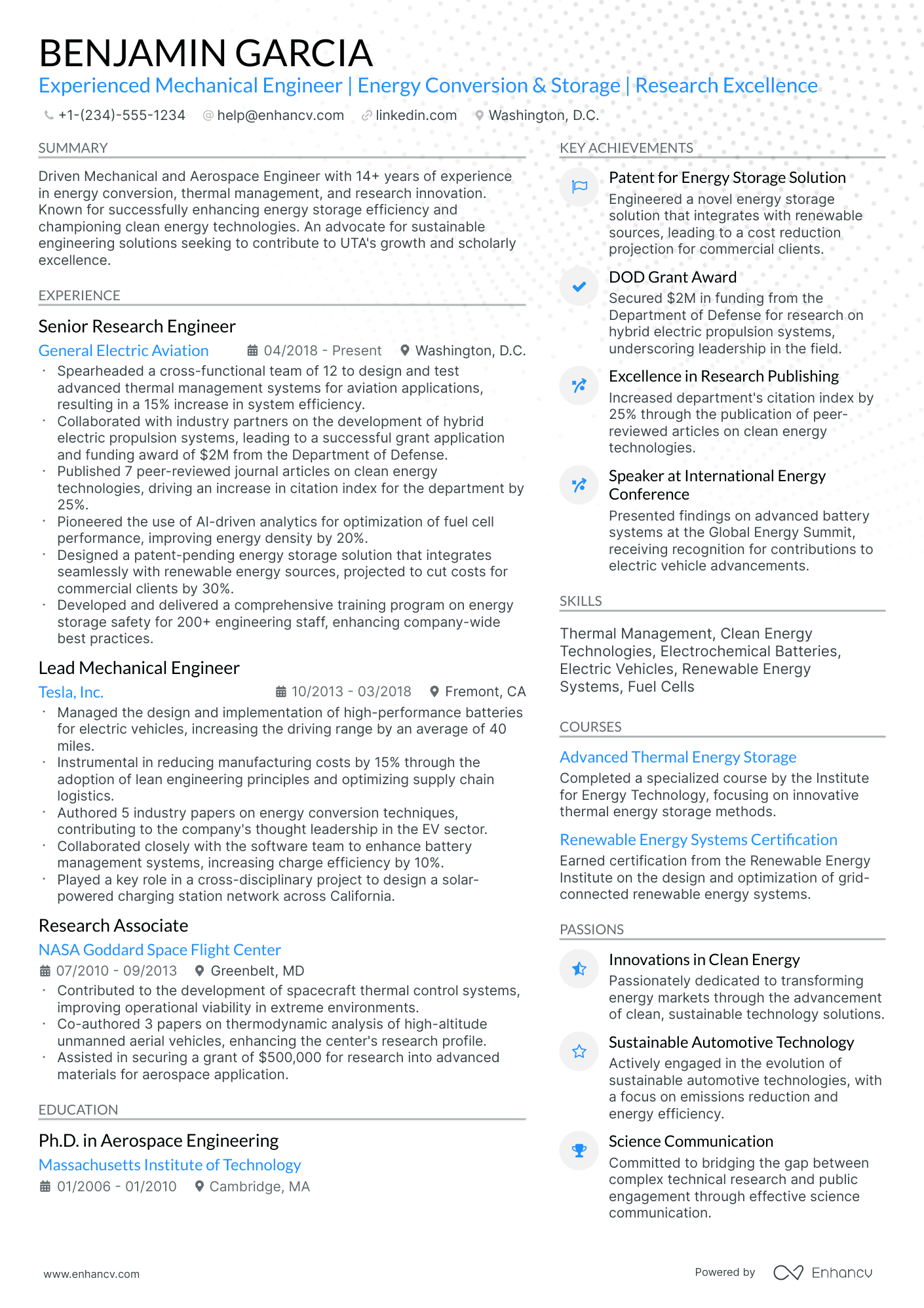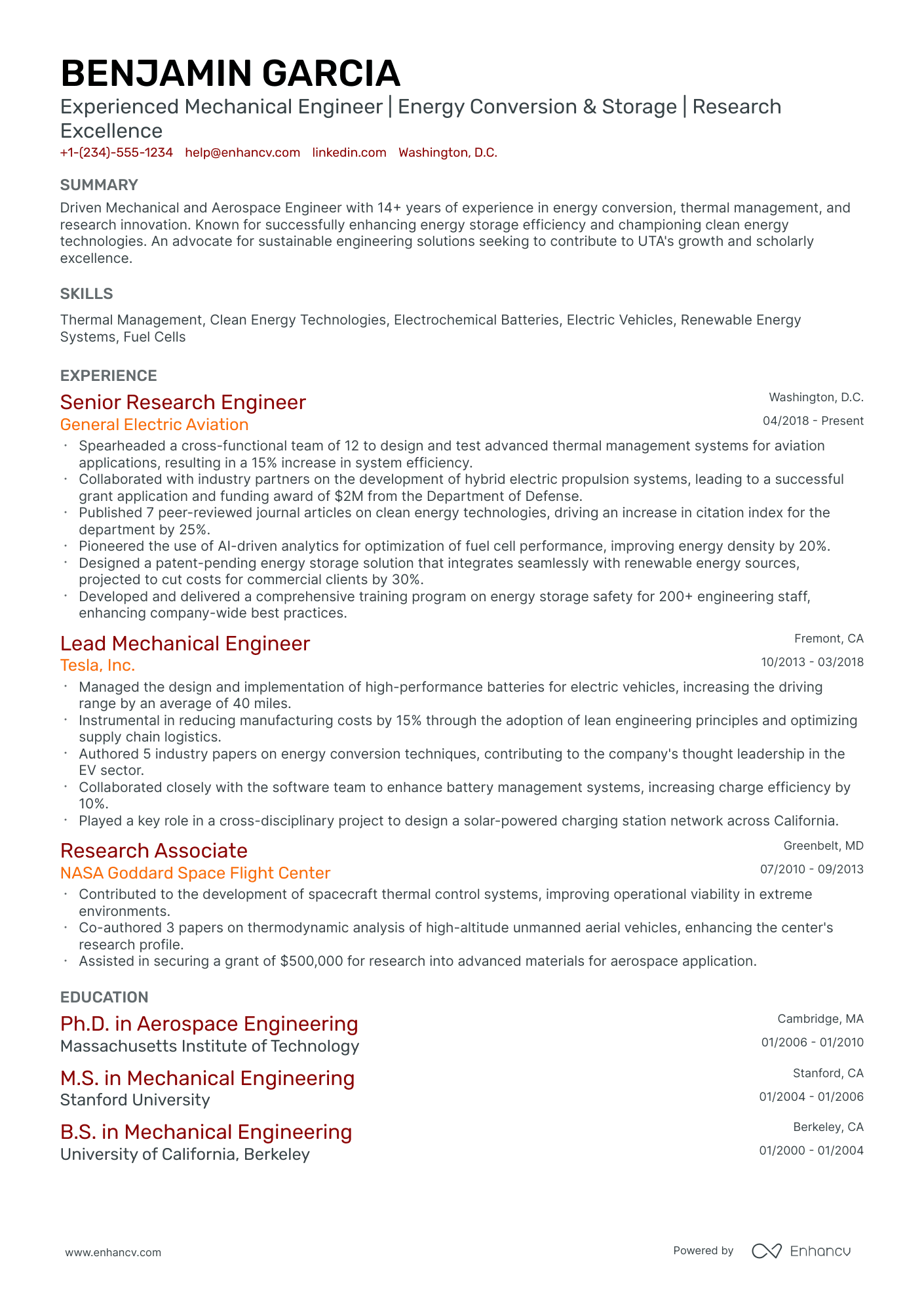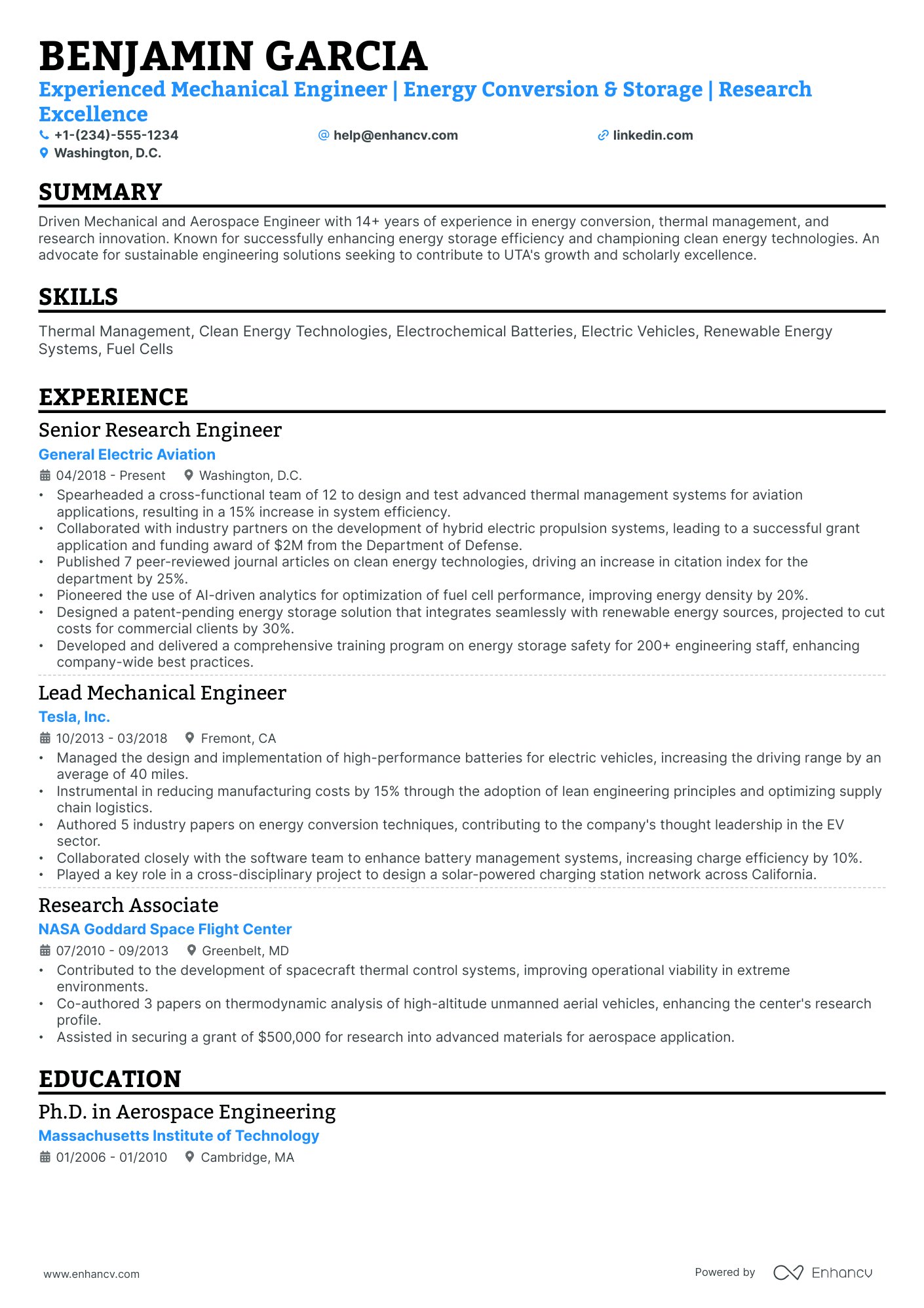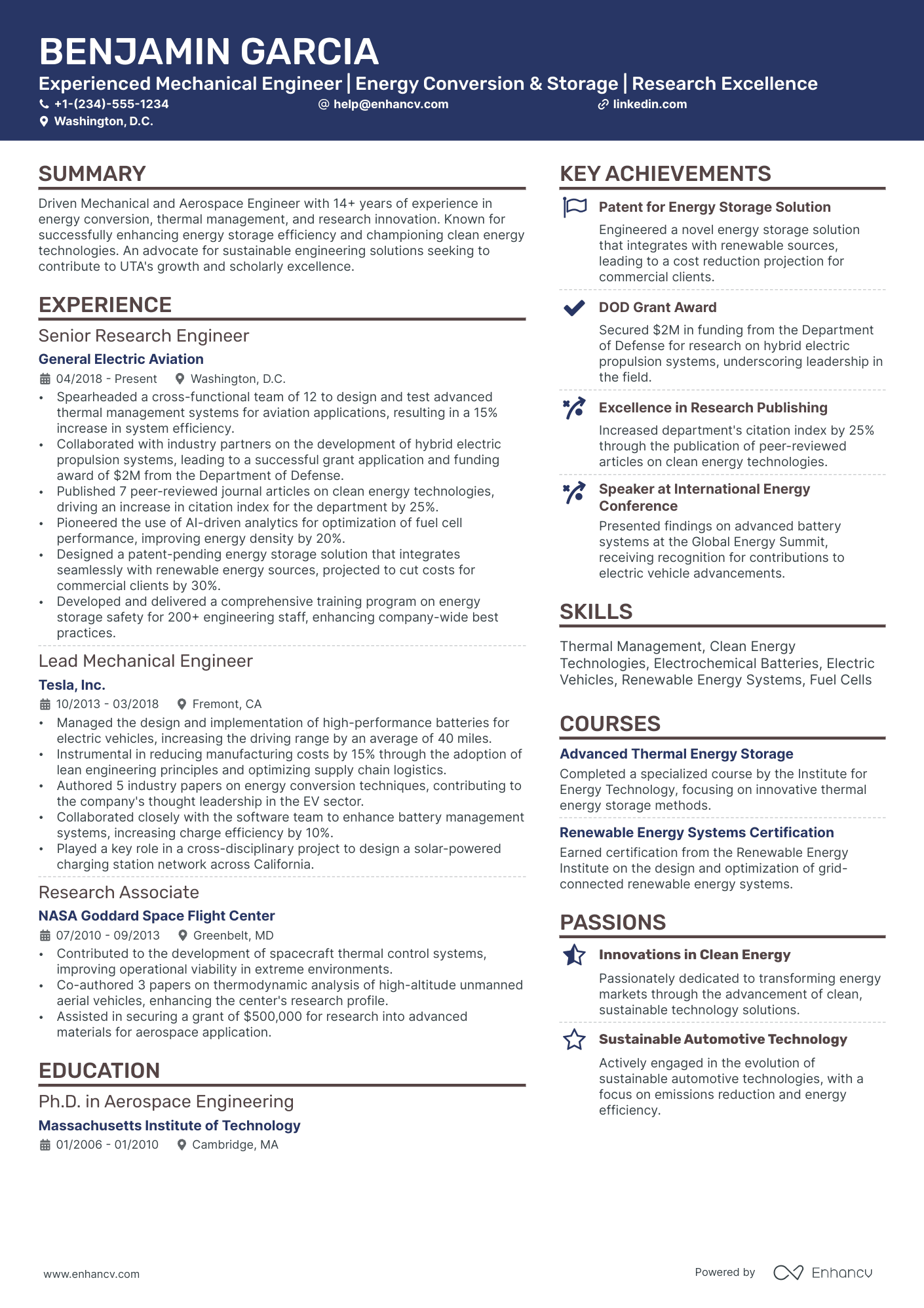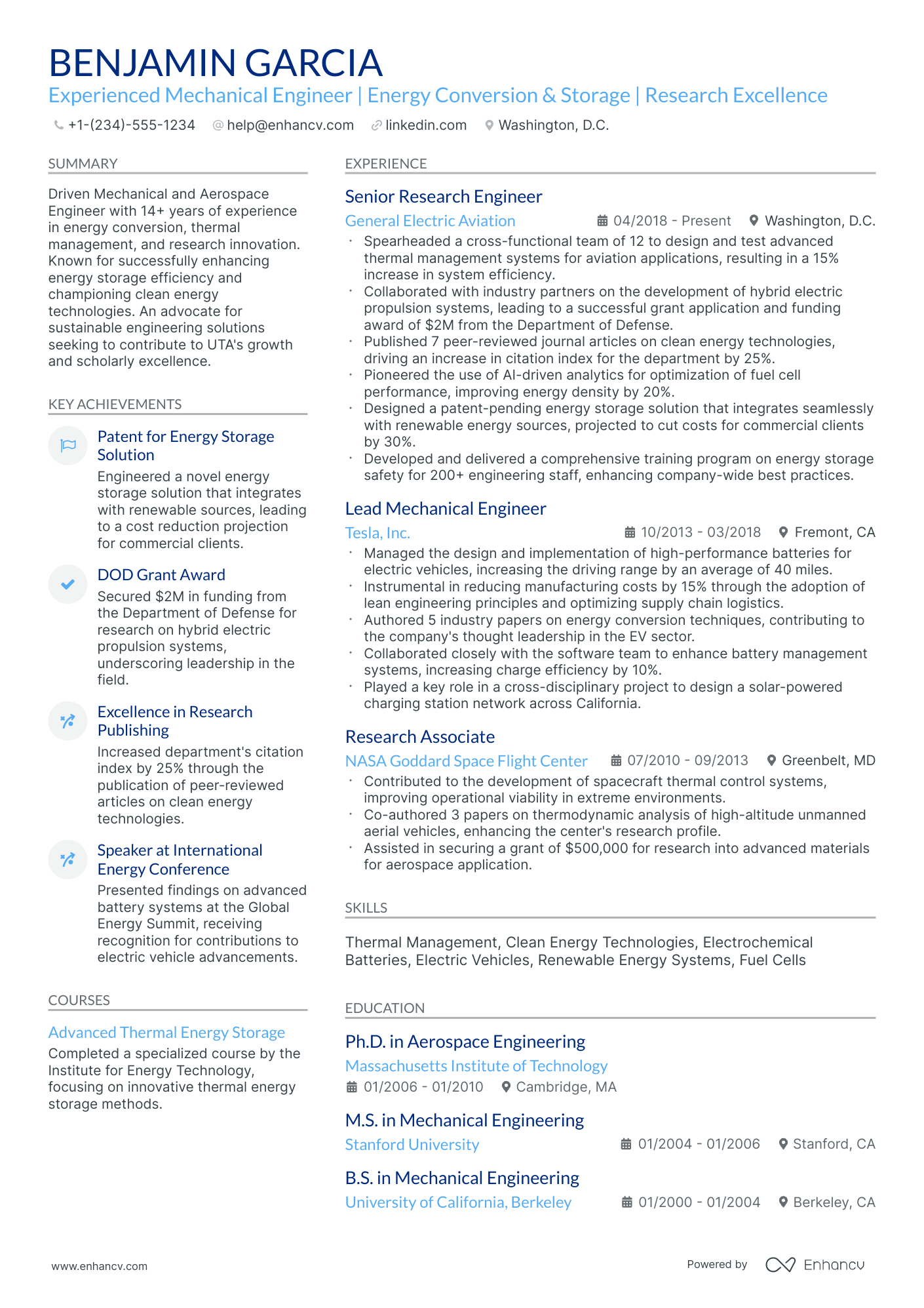As an aerospace engineer, articulating the complexity of your technical projects to a layperson audience in a resume can be an overwhelming task. Our expert-crafted guide provides clear strategies to break down your expertise into comprehensible achievements that will catch any employer's eye.
- Incorporate aerospace engineering job advert keywords into key sections of your resume, such as the summary, header, and experience sections;
- Quantify your experience using achievements, certificates, and more in various aerospace engineering resume sections;
- Apply practical insights from real-life aerospace engineering resume examples to enhance your own profile;
- Choose the most effective aerospace engineering resume format to succeed in any evaluation process.
- Electrical Project Manager Resume Example
- Petroleum Engineer Resume Example
- Engineering Program Manager Resume Example
- Automotive Engineering Resume Example
- Geotechnical Engineering Resume Example
- Director of Engineering Resume Example
- Construction Superintendent Resume Example
- Construction Manager Resume Example
- Landscape Architect Resume Example
- Architectural Project Manager Resume Example
Optimize your aerospace engineering resume format to pass the recruiters' assessment
You may be wondering just how much time you need to spend on designing your aerospace engineering resume.
What recruiters are looking for is systematised content that is clear and coherent. Thus, your aerospace engineering resume needs to answer requirements and why you're the best candidate for the role from the get-go.
Often, a clear layout consists of:
- Sorting your experience in the reverse chronological order - starting with your most recent and relevant roles. This is an excellent choice for more experienced professionals;
- Writing your contact information (e.g. personal phone number and email address) and your portfolio or LinkedIn link in your aerospace engineering resume header. If you're wondering to include a photo or not, always make sure that it's appropriate for the country you're applying in;
- Use the basic, most important aerospace engineering resume sections - your experience, education, summary, etc. Use your resume's real estate wisely to tell a compelling, professional story and match job description's keywords;
- Don't go overboard with the length of your resume. One page is absolutely fine if you happen to have under a decade of relevant experience.
Are you still wondering if you should submit your aerospace engineering resume in demystify three of the biggest misconceptions about how it assesses candidate resumes.
To pass the ATS evaluation, select any of the serif or sans-serif fonts. Popular choices that would help your aerospace engineering resume stand out include Raleway, Exo 2, Montserrat, etc.
Most traditionalists go for Arial or Times New Roman, but it's often the case that many candidates choose these fonts, and you'd thus lose points on the uniqueness front.
Each market has its own resume standards – a Canadian resume layout may differ, for example.
Upload & Check Your Resume
Drop your resume here or choose a file. PDF & DOCX only. Max 2MB file size.
PRO TIP
If you're in the process of obtaining your certificate or degree, list the expected date you're supposed to graduate or be certified.
Traditional sections, appreciated by recruiters, for your aerospace engineering resume:
- Clear and concise header with relevant links and contact details
- Summary or objective with precise snapshot of our career highlights and why you're a suitable candidate for the aerospace engineering role
- Experience that goes into the nuts and bolts of your professional qualifications and success
- Skills section(-s) for more in-depth talent-alignment between job keywords and your own profile
- Education and certifications sections to further show your commitment for growth in the specific niche
What recruiters want to see on your resume:
- Relevant educational background in aerospace engineering or related fields such as aeronautical engineering or mechanical engineering.
- Experience with aerospace software tools such as CATIA, SolidWorks, MATLAB, or ANSYS for design, simulation, and analysis.
- Understanding of aerospace standards, regulations, and compliance, such as FAA or EASA certification processes.
- Internship or project experience involving aircraft design, propulsion systems, aerodynamics, or spacecraft systems.
- Demonstrated skills in problem-solving and innovation in the field of aerospace, including any patents, publications, or presentations related to aerospace technology.
Advice for your aerospace engineering resume experience section - setting your application apart from other candidates
Your resume experience section needs to balance your tangible workplace achievements with job requirements.
The easiest way to sustain this balance between meeting candidate expectations, while standing out, is to:
- Select really impressive career highlights to detail under each experience and support those with your skills;
- Assess the job advert to define both the basic requirements (which you could answer with more junior roles) and the more advanced requirements - which could play a more prominent role through your experience section;
- Create a separate experience section, if you decide on listing irrelevant experience items. Always curate those via the people or technical skills you've attained that match the current job you're applying for;
- Don't list experience items from a decade ago - as they may no longer be relevant to the industry. That is, unless you're applying for a more senior role: where experience would go to demonstrate your character and ambitions;
- Define how your role has helped make the team, department, or company better. Support this with your skill set and the initial challenge you were able to solve.
Take a look at how real-life aerospace engineering professionals have presented their resume experience section - always aiming to demonstrate their success.
- Developed and implemented advanced aerodynamics simulation models to improve aircraft performance, resulting in a 15% reduction in drag for the new fleet.
- Managed a cross-functional team of 25 engineers in the design and testing of a novel propulsion system, achieving 10% increased fuel efficiency compared to existing models.
- Collaborated closely with manufacturing partners to streamline production processes, decreasing build times by 20% without compromising on safety or quality.
- Oversaw the integration of a state-of-the-art avionics suite into commercial aircraft, enhancing navigation and safety features for pilots.
- Conducted rigorous wind tunnel testing to validate new wing designs, directly contributing to a 5% uplift in aircraft performance metrics.
- Authored a whitepaper on the impact of composite materials in aerospace engineering that was published in a major industry journal, influencing future design standards.
- Led the retrofitting of commercial airliners with next-generation satellite communication systems to enhance global navigation and inflight connectivity.
- Mentored a team of junior aerospace engineers, increasing department productivity by 30% through optimized workflow processes.
- Pioneered the use of advanced predictive maintenance algorithms, reducing system downtime by 40% for the company’s flagship aircraft line.
- Executed detailed structural analysis for critical spacecraft components, ensuring design robustness for a mission to Mars which was televised globally.
- Facilitated collaboration with international partners to comply with various aerospace regulatory frameworks, ensuring timely project delivery.
- Introduced 3D printing techniques to prototype spacecraft parts, reducing prototype costs by 25% and accelerating the design phase by two months.
- Instrumental in redesigning the landing gear system of a heavy aircraft, improving its load capacity by 18% while maintaining compliance with FAA regulations.
- Successfully established and led a specialized engineering task force to troubleshoot mission-critical anomalies during test flights.
- Spearheaded a sustainability initiative in engineering practices which reduced waste by 30% and incorporated eco-friendly materials in production.
- Implemented an enhanced flight control algorithm that improved aircraft stability under turbulent conditions, greatly increasing passenger comfort and safety.
- Coordinated the transition to a lean manufacturing system, which cut production costs for military drones by 20% while improving build precision.
- Engaged in critical failure mode and effects analyses, leading to a reduction in unforeseen maintenance for the company's helicopter division by 22%.
- Designed cutting-edge thermal protection systems for hypersonic vehicles, achieving market leadership in high-speed flight applications.
- Developed and managed a comprehensive testing protocol for launch vehicle components that met and surpassed stringent industry safety standards.
- Orchestrated the deployment of computer-aided design tools which reduced the design cycle time of aircraft components by 35%.
- Transformed analytical methodologies for aircraft stress tests, yielding a 10% improvement in accuracy and reliability of results.
- Authored and implemented a comprehensive risk management plan for aerospace products, effectively diminishing project risks by 15%.
- Proactively engaged in industry forums representing the company, resulting in the establishment of fruitful partnerships with key aerospace technology providers.
Quantifying impact on your resume
- Included a specific number of engineering projects led, demonstrating project management skills and experience.
- Outlined the percentage of efficiency improvements achieved in systems or processes to showcase problem-solving capabilities.
- Quantified the size and scope of teams managed, illustrating leadership and team-building strengths.
- Described the budgetary figures managed, indicating competence in financial and resource allocation.
- Provided the amount of cost savings realized through design optimization, reflecting a strong understanding of value engineering.
- Reported the number of technical papers or research articles published, evidencing expertise and thought leadership in aerospace engineering.
- Measured improvements in product performance or reliability in numerical terms to demonstrate analytical and result-oriented mindset.
- Indicated the scale of simulations or computational models developed, revealing depth of technical skills and attention to detail.
Action verbs for your aerospace engineering resume
What can candidates do about their resume, if they have no experience
Job requirements can sometimes be answered by other elements you could make more prominent in your aerospace engineering resume.
Thus, you'd be substituting your lack of experience with your relevant:
- Education with details of skills you've obtained that align with the job
- Internships and short-term jobs that are once more dedicated to putting your expertise in the spotlight
- Skills section answering basic and - potentially - more specific job qualifications
- Strengths or accomplishments to show the unique value you present, even as a candidate with less or no professional experience in the industry.
Recommended reads:
PRO TIP
List all your relevant higher education degrees within your resume in reverse chronological order (starting with the latest). There are cases when your PhD in a particular field could help you stand apart from other candidates.
Featuring your hard skills and soft skills on your aerospace engineering resume
The skills section of your aerospace engineering resume needs to your various capabilities that align with the job requirements. List hard skills (or technical skills) to showcase to potential employers that you're perfectly apt at dealing with technological innovations and niche software. Meanwhile, your soft skills need to detail how you'd thrive within your new, potential environment with personal skills (e.g. resilience, negotiation, organization, etc.) Your aerospace engineering resume skills section needs to include both types of skills to promote how you're both technical and cultural fit. Here's how to create your bespoke aerospace engineering skills section to help you stand out:
- Focus on skill requirements that are listed toward the top of the job advert.
- Include niche skills that you've worked hard to obtain.
- Select specific soft skills that match the company (or the department) culture.
- Cover some of the basic job requirements by including important skills for the aerospace engineering role - ones you haven't been able to list through the rest of your resume.
Get inspired with our aerospace engineering sample skill list to list some of the most prominent hard and soft skills across the field.
Top skills for your aerospace engineering resume:
Computer-Aided Design (CAD)
Finite Element Analysis (FEA)
Computational Fluid Dynamics (CFD)
Systems Engineering
Propulsion Systems
Aerodynamics
Avionics
Materials Science
Control Systems
Project Management Software
Problem-Solving
Teamwork
Communication
Critical Thinking
Attention to Detail
Time Management
Adaptability
Creativity
Analytical Thinking
Leadership
PRO TIP
If you failed to obtain one of the certificates, as listed in the requirements, but decide to include it on your resume, make sure to include a note somewhere that you have the "relevant training, but are planning to re-take the exams". Support this statement with the actual date you're planning to be re-examined. Always be honest on your resume.
Showcase academic background with education and certifications' sections
Listing your education and certifications should be a rudimentary part of your resume writing.
Including your relevant academic background - in the form of your higher education degree and niche-specific certificates - will prove knowledge of the industry.
For your education section:
- Start by including your degree, followed by start and graduation dates, as well as the institution;
- You could include relevant coursework, major/minor , or GPA, only if your've just graduated from college or if this information would further support your application;
- If you have an "ongoing" degree, you can still list it in case you think your diploma can impress recruiters or it's required;
Follow a similar logic for your certifications section by listing the institution, alongside dates you've obtained the certificate. For some of the most recent and relevant industry certificates , check out the next part of our guide:
The top 5 certifications for your aerospace engineering resume:
- Certified Systems Engineering Professional (CSEP) - International Council on Systems Engineering (INCOSE)
- Project Management Professional (PMP) - Project Management Institute (PMI)
- Aerospace Engineer Certification (AEC) - Various Aerospace Institutions and Boards
- Professional Engineer (PE) License - National Society of Professional Engineers (NSPE)
- FAA Certifications for Engineers (Various, e.g., DER) - Federal Aviation Administration (FAA)
PRO TIP
Bold the names of educational institutions and certifying bodies for emphasis.
Recommended reads:
Practical guide to your aerospace engineering resume summary or objective
First off, should you include a summary or objective on your aerospace engineering resume?
We definitely recommend you choose the:
- Resume summary to match job requirements with most noteworthy accomplishments.
- Resume objective as a snapshot of career dreams
Both the resume summary and objective should set expectations for recruiters as to what your career highlights are.
These introductory paragraphs (that are no more than five sentences long) should help you answer why you're the best candidate for the job.
Industry-wide best practices pinpoint that the aerospace engineering resume summaries and objectives follow the structures of these samples:
Resume summaries for a aerospace engineering job
- Seasoned aerospace engineer with over 12 years of experience specializing in computational fluid dynamics and structural analysis within the defense sector. Recognized for pioneering lightweight composite materials that resulted in a 15% increase in airframe durability under high-stress conditions. Seeking to leverage in-depth industry knowledge and technical expertise in a challenging environment.
- Dedicated aviation systems engineer, with a decade of hands-on experience in designing and improving commercial aircraft systems. Excelled in aerodynamic optimization, reducing fuel consumption by 20% for a fleet of airliners. Expertise in integrating eco-friendly propulsion technologies, aligning with sustainability trends in aviation engineering.
- Accomplished web developer transitioning into aerospace engineering, bringing a unique perspective with 7 years of experience in software architecture and a passion for physics and aviation technology. Highly proficient in algorithm design and data analysis with a track record of developing robust, user-centric applications that have increased user engagement by 30%.
- Ambitious mechanical engineer shifting focus to aerospace, possessing an extensive 8-year background in automotive design, high-precision machinery, and thermal management. Skillful in 3D CAD modelling and simulation, aiming to contribute cross-industrial innovation and a fresh outlook on aerodynamic efficiency in space vehicle development.
- Recently graduated magna cum laude with a Master's in aerospace engineering, eager to apply academic knowledge and fresh, cutting-edge research insights into real-world applications. Pursuing a career start that will allow for hands-on experience in satellite technology development, guided by a passion for space exploration and a commitment to advancing human presence beyond Earth.
- Highly motivated individual with a strong foundation in mathematics and physics from a Bachelor's in Engineering Physics. Aspires to mould a career in aerospace engineering, looking to harness a profound enthusiasm for aircraft design and propulsion systems. Keen on contributing youthful energy and contemporary theoretical knowledge to developing next-generation aviation solutions.
What else can you add to your aerospace engineering resume
What most candidates don't realize is that their aerospace engineering resumes should be tailored both for the job and their own skillset and personality.
To achieve this balance between professional and personal traits, you can add various other sections across your resume.
Your potential employers may be impressed by your:
- Awards - spotlight any industry-specific achievements and recognitions that have paved your path to success;
- Languages - dedicate some space on your aerospace engineering resume to list your multilingual capabilities, alongside your proficiency level;
- Publications - with links and descriptions to both professional and academic ones, relevant to the role;
- Your prioritization framework - include a "My Time" pie chart, that shows how you spend your at-work and free time, would serve to further backup your organization skill set.
Key takeaways
- All aspects of your resume should be selected to support your bid for being the perfect candidate for the role;
- Be intentional about listing your skill set to be balanced with both technical and people capabilities, while aligning with the job;
- Include any experience items that are relevant to the role and ensure you feature the outcomes of your responsibilities;
- Use the summary or objective as a screenshot of your best experience highlights;
- Curate various resume sections to showcase personal, transferable skills.
